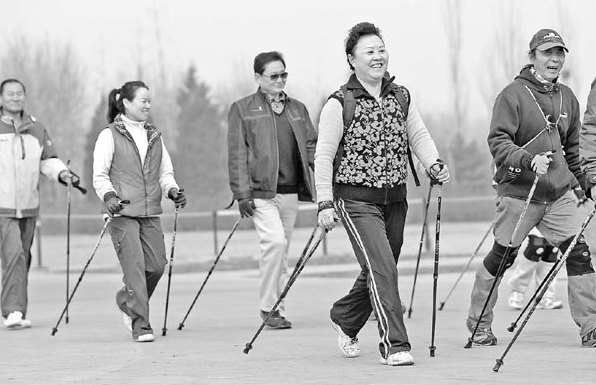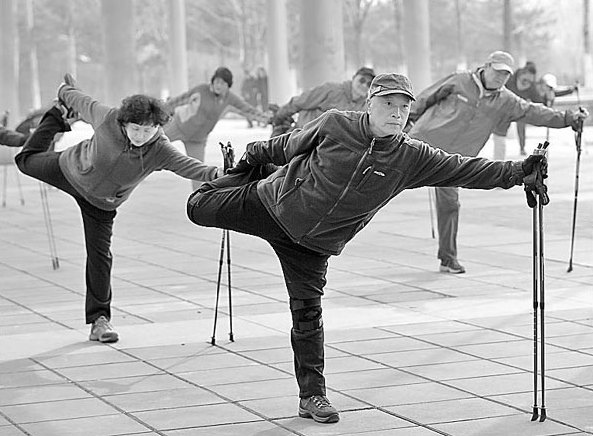Walking their way to health
Updated: 2013-04-05 07:44
By Peng Yining (China Daily)
|
||||||||
|
Residents take part in Nordic walking in the Beijing Olympic Forest Park. The walking group in the park has grown from 10 people five years ago to more than 80 in 2013. Photos by Zou Hong / China Daily |
Getting fit is just that easy, thanks to a pole-assisted regimen invented by Finns and adopted by Chinese, reports Peng Yining
When Wang Xinming first saw people "Nordic walking" in a park - using a pair of poles while walking naturally - he thought only people with a physical disability would walk with sticks.
But after he tried it once, the 68-year-old former civil servant soon became an enthusiast of this growing sport, which was developed in Finland in 1997 and introduced into China a decade ago.
The use of poles reduces the stress on joints, especially protecting knees during a workout. The pole action also strengthens the upper body.
Wang said he suffered from arthritis for more than 10 years. His knees used to "hurt like hell" when he climbed stairs, or in cold weather. But after five years of Nordic walking, he's feeling the pain gradually dissipate. In a Nordic walking competition in 2011 in Beijing, he walked 16 kilometers in two hours and 20 minutes - with no pain.
"The poles are like two extra legs," he said. "I walk easier and faster."
Wang has lost 15 kilograms of weight since he started to walk, and his high blood pressure and blood sugar level have dropped back to normal.
On a recent Friday morning, Wang and a dozen Nordic walkers, most of them over 50, raced down a path in the icy morning wind in Beijing's Olympic Forest Park, leaving far behind the easy-paced joggers and tai chi morning exercisers.
Nordic walking was first introduced into China by China Institute of Sport Science in 2003. Begun in Beijing and later moving on to other cities, Nordic walking is now promoted and practiced in 20 cities.
According to a report from China Nordic Walking Association, China has around 100,000 Nordic walkers and 20,000 people practice regularly
In Beijing, there are 30 parks which have Nordic walking clubs. More than 100 government units and companies organize walk training for their employees. It was also introduced in 2008 Beijing Olympic promotion events, and in 2010, Nordic walking orienteering was part of China Orienteering Competition.
Since 2008, Beijing has been annually organizing an International Nordic Walking Event with over 1,000 participants each time, including walkers from the Japan Nordic Walking Association and from Finland.
"Nordic walking is becoming a popular park game, or exercise for Chinese people," said Yao Xinxin, head coach of the International Nordic Walking Association in China. As a sports science specialist at the China Institute of Sport Science, he was the one who first introduced Nordic Walking to China.
"Now Chinese companies produce our own walking poles and other accessories," he said. "We are also making the exotic sport more localized."
Yao said in the Europe, Nordic walkers more often workout as individuals, but in China it is more like a group game.
The walking group in Beijing Olympic Forest Park has grown from 10 people five years ago to more than 80 in 2013. During the weekends, the number could be more than 100, said Hou Xiaodong, 62, the group organizer.
Most walkers are retirees, Hou said. Although most senior people live with their children in China, their busy schedules and the gap between generations mean elderly urgently need a healthy social life as well as physical activity.
"It is boring and lonely jogging or playing tai chi by yourself," Hou said. "But you can chat with your friends while Nordic walking. You can work out and socialize at the same time."
After setting out, walkers in the forest park split as their walking speeds vary, but still stick with smaller groups. Hou and another eight walkers talked about news, TV programs, and soup recipes. Laughter bursts out occasionally in the group.
Hou is constantly greeting other walkers as they pass by. "I've gotten to know most people walking here. Having a nice talk with them is a great start of a day," she said. "Sometimes when I feel lazy, I still come to walk, because I would miss my friends who walk and they would ask about me."
The Institute of Sport Science also designed a pole exercise for Chinese walkers - stretching the body with the help of walking poles - which is unique to China.
Now the exercise has been introduced to all Nordic walking clubs in Beijing, for warming up and recovery before and after walking. In order to create more interactions between walkers, the exercise has some movements that need two people to cooperate, such as two people holding opposite ends of the poles and help each other stretch muscles in the arms and back.
The exercise is widely welcomed among Chinese walkers. As people usually do it with fast electronic music, some of walkers said it is also kind of "park dancing", only more athletic.
On a tour organized by the China Nordic Walking Association, Chinese walkers go to walk in Finland, where the sport was invented, twice a year. In 2012, 58 walkers hiked across the central park of Helsinki.
Xiao Gang, head of the association, said Nordic walking was introduced to China six years after it was created, but now it has been developing faster than it does in the Europe.
"Based on the larger population, the target group is bigger in China," he said. "Most importantly, the sense of healthy lifestyle is growing stronger in our country."
Xiao has also seen a business opportunity in the growing recreation. He said the price of a pair of poles range from 168 yuan ($27) to more than 900 yuan, which most urban residents could afford.
"Being healthy is more important than anything," said Hu Shuqin, a 58-year-old walker who spent 490 yuan on a pair of lightweight poles made of carbon fiber.
"I would spend much more on medication if I haven't been working out," she said. "Nordic walking makes my life healthier and happier."
At the beginning Hu said she was a little embarrassed walking with poles in public, but after a while she got completely comfortable.
"I tell jokes and even sing for people walking with me," she said. "I have tried jogging, swimming, playing tai chi after I retried, but none of them are as good as walking."
Chen Zhengyi, 81, walks five kilometers every day in past two years. "I thought I would be using walking poles in my 80s, now I am, but in an athletic way," he said. "I don't feel like 80 at all."
According to a report from the Institute of Sport Science, 90 percent of body muscle works while Nordic walking. It consumes 20 to 46 percent more calorie than regular walking with the same speed, time and length.
In a survey of more than 400 Chinese Nordic walkers in 2012, 70 percent said their knee pain has been eased after they adopted the exercise; 85 percent have less backache; 65 percent lost weight; 80 percent have lower level of blood fat.
The China Sports Association for Elderly People has been promoting Nordic walking since 2005. The Chinese Medical Doctor Association also recommends Nordic walking as one of the best ways to prevent cardiovascular diseases.
But the promotion does not always go well, said Xiao Gang. The sport began in Europe as off-season training of skiers in the Europe.
Since most Chinese people have no experience of skiing, walking with poles seems weird and embarrassed. It is also mostly adopted by elderly people, and Xiao said it would be helpful if the younger generations participate.
"But I believe it is getting more popular, as with something as simple as a pair of poles, people can benefit from the most regular physical activity," Xiao said. "The increasing number of walkers indicates the rising demand for healthy lifestyle in China, in the world's second-largest economy."
Contact the writer at pengyining@chinadaily.com.cn
|
Participants stretch their bodies with the help of poles in the Beijing Olympic Forest Park, to warm up or recover before and after walking. |
(China Daily 04/05/2013 page8)

 In Photos: 7.0-magnitude quake hits Sichuan
In Photos: 7.0-magnitude quake hits Sichuan
 Li Na on Time cover, makes influential 100 list
Li Na on Time cover, makes influential 100 list
 FBI releases photos of 2 Boston bombings suspects
FBI releases photos of 2 Boston bombings suspects
 World's wackiest hairstyles
World's wackiest hairstyles
 Sandstorms strike Northwest China
Sandstorms strike Northwest China
 Never-seen photos of Madonna on display
Never-seen photos of Madonna on display
 H7N9 outbreak linked to waterfowl migration
H7N9 outbreak linked to waterfowl migration
 Dozens feared dead in Texas plant blast
Dozens feared dead in Texas plant blast
Most Viewed
Editor's Picks

|

|

|

|

|

|
Today's Top News
Live report: 7.0-magnitude quake hits Sichuan, heavy casualties feared
Boston suspect cornered on boat
Cross-talk artist helps to spread the word
'Green' awareness levels drop in Beijing
Palace Museum spruces up
First couple on Time's list of most influential
H7N9 flu transmission studied
Trading channels 'need to broaden'
US Weekly

|

|









